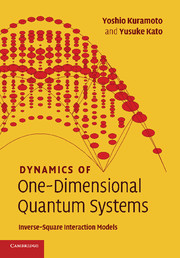10 - Uglov's theory
from Part II - Mathematics related to 1/r2 systems
Published online by Cambridge University Press: 12 January 2010
Summary
In this chapter, we give an example of how the Yangian theory works in practice in the calculation of physical quantities. Using the Yangian representation theory, calculation of the dynamical correlation function of the Sutherland model with glK symmetry can be performed in the same way as (a modified version of) the single-component Sutherland model [189]. Namely, Uglov [189] showed that the spin and the spatial momentum can be unified as a fictitious momentum. This spin–momentum unification is particularly powerful for exact derivation of spin correlation functions [189, 197]. Further development for the SU(K) chain has also been achieved [198, 199]. Uglov's theory is outlined in this chapter.
In Section 10.1 we introduce as a prelude the symmetric Macdonald polynomials, which include the symmetric Jack polynomials as a special case. Then in Section 10.2, Uglov symmetric polynomials are introduced as another limit of symmetric Macdonald polynomials. We explain in Section 10.3 an isomorphism between the Fock space of the Sutherland model with SU(2) internal symmetry and the space of Laurent symmetric polynomials. The isomorphism by which the Yangian Gelfand–Zetlin basis is mapped onto the Uglov polynomials preserves the inner product. By this isomorphism, density and spin-density operators in the U(2) model find their correspondence in the single-component model. In this way, the calculations of dynamical density and spin-density correlation functions in the U(2) Sutherland model reduce to those of a modified version of the single-component Sutherland model.
Macdonald symmetric polynomials
We have seen in Section 2.5 that the Jack symmetric polynomials can be defined as the homogeneous symmetric polynomials of z = (z1, …, zN) satisfying conditions of triangularity (2.177) and orthogonality (2.196).
- Type
- Chapter
- Information
- Dynamics of One-Dimensional Quantum SystemsInverse-Square Interaction Models, pp. 441 - 454Publisher: Cambridge University PressPrint publication year: 2009

